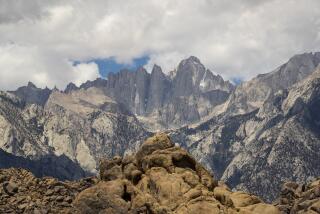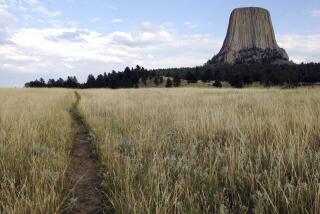9 feared dead in K2 avalanche
- Share via
ISLAMABAD, PAKISTAN — At least nine climbers were feared dead Sunday after ice sheared off the summit of K2 and crashed down the mountain, sweeping away fixed ropes and leaving some mountaineers trapped in the dark.
The catastrophe on the world’s second-tallest peak cast a pall over the international climbing community and caused one mountaineer to report on a website from Base Camp: “There’s a taste of death in this place.”
Reports were conflicting. The Alpine Club of Pakistan, the country where K2 is located, placed the death toll at nine and said several climbers remained missing. Everest news.com had a list of 11 dead, while another climbing website, K2climb.net, reported that only one body had been found.
The difficult terrain on the Himalayan giant on the Pakistani-Chinese border makes it nearly impossible to carry out a large search-and-rescue mission, so it may take days or even weeks to get precise details.
But this could rank as the deadliest climbing episode since the 1996 Mt. Everest disaster, during which eight people perished, made famous by Jon Krakauer’s bestselling book “Into Thin Air.”
Although K2, at 28,251 feet, is not as tall as Everest, at 29,035 feet, it is considered tougher to climb because of unrelenting bad weather and steep and difficult terrain from every approach. Climbers must be adept in rock and ice climbing, as well as general mountaineering.
“It’s one of those mountains where, once you’ve climbed it, you don’t ever go back,” said Ed Viesturs, a climbing legend who lives in Washington state. “For every step you go up, it tries to bring you down.”
It has been referred to as “the Savage Mountain,” and in 1986, in what is referred to as the K2 Tragedy, 13 climbers from various expeditions succumbed during a severe storm.
Death or disorientation from exposure can occur rapidly at high elevations, and climbers are sometimes rendered immobile by frostbite and hypothermia. But some climbers have survived for days.
The accident also has raised the issue anew: Has commercial mountaineering grown too large, and are too many inexperienced climbers being led into such a potentially perilous realm?
“Many people buy these packages to K2 and especially to Everest,” Italian climber Reinhold Messner told Reuters news agency. “They are certainly strong people, but they do not have enough experience to react.”
Some have also blamed large-scale commercial mountaineering for a diminished moral code. The cost to join an expedition is $10,000 to $40,000, and those spending such sums expect to reach the summit.
Two years ago on Mt. Everest, several expeditions marched purposefully past British climber David Sharp, who was hunkered down but within sight, deprived of oxygen and disoriented in the upper “death zone.”
Sharp died, and his body, like those of so many others, remains entombed on Everest’s slopes.
But Viesturs said in an interview that because K2 is so difficult, little if any commercial guiding takes place there.
“These are all professional climbers,” said Viesturs, who climbed K2 in 1992. “But even professional climbers with huge amounts of experience make mistakes. They also get into trouble. They’re also subjected to objective risks like this ice avalanche.”
What’s remarkable about the unfolding tragedy is that poor weather came into play only indirectly. When good weather finally prevailed last week, after a long spell of snow and wind, hordes of climbers set out from Base Camp.
The climbers and their tour operators were in touch by satellite phone, officials said.
The Pakistani army runs a mountain-rescue service that has plucked many climbers to safety in the past. But it offered no immediate information on the unfolding disaster.
Expeditions were varied in size and from numerous countries, among them South Korea, Serbia, Norway, Ireland, Pakistan, Nepal, the Netherlands and France.
The main summit push occurred Friday. There were logjams of climbers between Camp 3 and 4, and above Camp 4, which is the final acclimatization station.
Climbers from eight international expeditions, either approaching or descending the summit, reportedly were affected when the chunk of ice fell that day.
The ensuing avalanche apparently did not sweep climbers down the mountain, but it took fixed ropes above Camp 4 that are required to safely descend tough sections, especially for weary mountaineers.
The ice avalanche reportedly occurred in the dark, creating an even more perilous and chaotic situation.
Viesturs, who has climbed Everest six times, said because of K2’s difficulty and panache factor, “people are willing to push their limits harder to succeed -- and that means summiting late at night and climbing to exhaustion.”
“And all of those factors make a lot of people lose their lives on the mountain,” he said.
Over the weekend, the body of Serbian climber Dren Mandic was found near Camp 3 and buried there by fellow climbers, an expedition spokesman said. At least two members of a Korean expedition are said to have disappeared into a crevasse.
Cloudy weather has hampered an aerial survey, and a helicopter was standing by at Base Camp to provide transportation for the injured.
An erroneous report of a Dutch mountaineer’s death was withdrawn.
Wilco van Rooijen of the Norit expedition was spotted Saturday between Camp 4 and Camp 3, wearily plodding down the mountain, suffering from severe frostbite. As of Sunday, Van Rooijen was being treated at Camp 3.
An editorial on K2climb.net, which noted that only one body had been recovered, begged the media to stop reporting casualty figures that may not be accurate.
In reference to Van Rooijen, the editorial said, “Only on K2 this weekend, one of the 11 ‘dead’ climbers was found alive less than half a day ago. Several climbers are still coming down the Abruzzi ridge, their identities unknown.
“Mountaineering history is filled with examples of ‘ghosts’ walking into base camps,” the editorial said.
--
Special correspondent Zaidi reported from Islamabad and Times staff writer Thomas from Los Angeles. Times staff writer Laura King in Kabul, Afghanistan, contributed to this report.
More to Read
Sign up for The Wild
We’ll help you find the best places to hike, bike and run, as well as the perfect silent spots for meditation and yoga.
You may occasionally receive promotional content from the Los Angeles Times.






